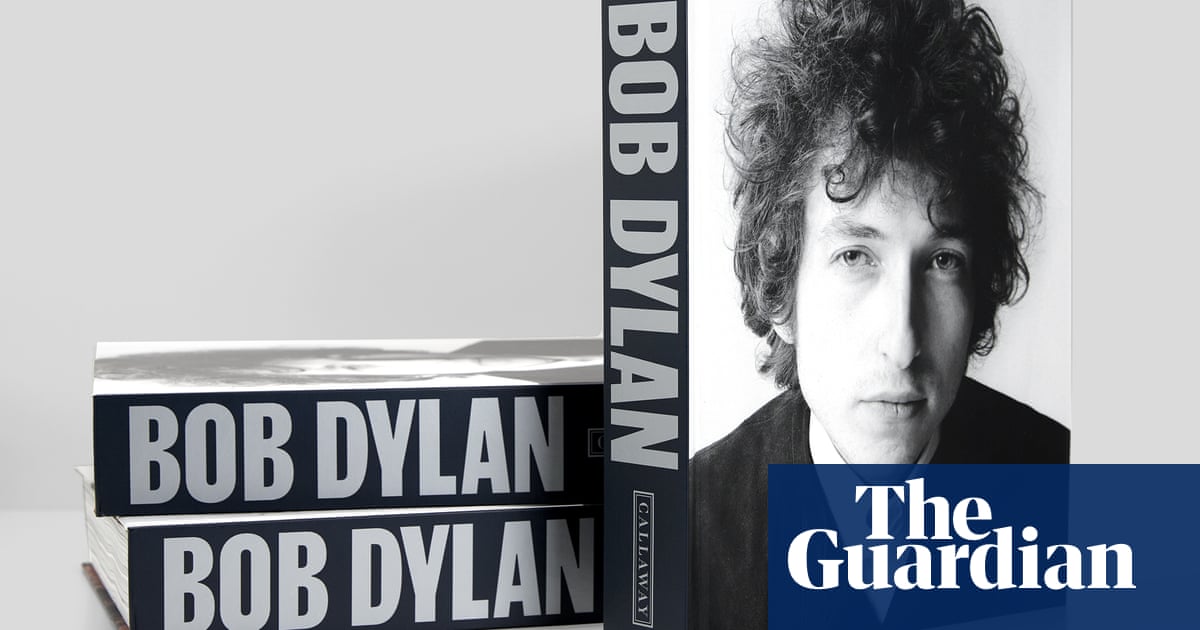
Ten years before he became Bob Dylan, 10-year-old Bobby Zimmerman had his first mystical experience. Wandering through the house his father had bought in Hibbing, Minnesota, he discovered a guitar in one room, and then “a great big mahogany radio” with “a 78 turntable when you opened up the top” in another.
Sitting on the platter was a country record called Drifting Too Far from Shore. The record with a prophetic title “made me feel like I was somebody else”, Dylan remembered. “That I was maybe not even born to the right parents or something.”
A couple of years later, the young radio addict began to imagine the person he was supposed to be when Little Richard’s cleaned-up version of Tutti Frutti seized the airwaves with its unforgettable “a-wop-bop-a-loo-mop-alop-bam-boom” refrain and became the founding song of rock’n’roll. (Bobby’s high school yearbook would announce his ambition: “To join Little Richard.” His girlfriend then was Echo Helstrom, who might be the subject of Girl from the North Country.)
When Buddy Holly released That’ll Be the Day, Bobby got his next inspiration. The gangling, goofy-looking six-footer with horn-rimmed glasses and the irresistible aw-shucks charm of Lubbock, Texas, made two appearances on The Ed Sullivan Show. For the boy from Hibbing it was love at first sight. From the moment he heard him, Bobby felt “akin, like he was an older brother. I even thought I resembled him. Buddy played the music that I loved – the music I grew up on: country western, rock’n’roll, and rhythm and blues. Three separate strands of music that he intertwined and infused into one genre. One brand. And Buddy wrote songs that had beautiful melodies and imaginative verses. And he sang great – sang in more than a few voices.”
A songwriter who fused multiple registers, and delivered them in multiple voices: the perfect model for a nice Jewish boy obsessed with music who was only a couple of years past his barmitzvah.
A year after Buddy’s second TV appearance, Bobby drove to Duluth (his birthplace) to see his hero in the flesh. The 17-year-old fan was thunderstruck.
“That was a few days before he was gone,” Dylan remembered. “I had to travel a hundred miles … I wasn’t disappointed. He was powerful and electrifying and had a commanding presence. I was only 6ft away. He was mesmerizing. I watched his face, his hands, the way he tapped his foot, his big black glasses, the eyes behind the glasses, the way he held his narrative, the way he stood, his neat suit. Everything about him. He looked older than 22. Something about him seemed permanent, and he filled me with conviction.
“Then, out of the blue, the most uncanny thing happened. He looked me right straight dead in the eye, and he transmitted something … and it gave me the chills.”
Three days later, the V-tailed single-engine Beechcraft aircraft Holly had chartered to avoid another freezing eight-hour bus ride crashed in an Iowa cornfield, killing him, Ritchie Valens, JP Richardson and the 21-year-old pilot. But the transference to his apostle was real.
So far, it has managed to keep Dylan performing for seven decades.
My devotion to The Man (what the Beatles called him) started when I sat in the stalls of the Royal Albert Hall in 1965 and stared into Dylan’s eyes during his final all-acoustic concert. That night, The Times They Are a-Changin’, It’s Alright, Ma (I’m Only Bleeding), Love Minus Zero/No Limit, Mr Tambourine Man and 11 other blockbusters were implanted into the psyches of a spellbound audience with nothing more than a harmonica, an acoustic guitar and an almost untraceable prairie voice – choices that gave him the affect of a drummer boy from the civil war, reincarnated as an outlaw from Appalachia.
That sound was largely borrowed from his third essential mentor, Woody Guthrie, whom Dylan discovered before he was 20 through Guthrie’s autobiography, Bound for Glory (another prophetic title). In the winter of 1961, Dylan traveled east to track down Guthrie and to find his fortune.
By then, what the historian Sean Wilentz called Dylan’s “gargantuan curiosity about history, literature and the visual arts” had propelled him through the search which led him to Guthrie, a perfect role model, the man who had written on his guitar “this machine kills fascists”.
Dylan’s first New York girlfriend, Suze Rotolo, introduced him to everyone from Brecht to Rimbaud, and Allen Ginsberg “rekindled his love for the beats”, Wilentz writes. Remarkably, at 22, Dylan was so self-possessed that even a blatant pass by Ginsberg when they first met never put Dylan off.
Barely a year after he reached New York, Dylan had been noticed and praised by the New York Times (“his music making has the mark of originality and inspiration”), he had signed a contract with Columbia Records, and he had seized the torch Guthrie and Pete Seeger had been carrying for folk music ever since a night in 1940 when they sparked its renaissance with a joint appearance on a New York stage, a year before Dylan was born.
In 1965, after just four years and four albums, Dylan abandoned the solo style which had made him the most famous American folk singer of all time.
“I could have continued to play the lone ranger,” he told me, when I interviewed him for my first book. “But I couldn’t go much farther by myself.” Thus began the process of constant reinvention which has continued ever since.
“He has always trusted his power,” said the artist Eugene Gregan, who was Dylan’s Ulster county neighbor when the singer lived in Woodstock, New York.
Whether you have inhaled this kind of information for decades, as I have, or you’re a neophyte who only knows him as the author of Blowin’ in the Wind or Like a Rolling Stone, Bob Dylan: Mixing Up the Medicine may fill you with as much surprise and delight as I got from it.
Subtitled Treasures from the Bob Dylan Center, Tulsa, Oklahoma, this is a 607-page, 11in-by-9in, five-and-a-half-pound behemoth with a dozen original essays, countless photographs, hundreds of illustrations, and plenty of connective tissue by authors Mark Davidson and Parker Fishel.
The Dylan Center opened in Tulsa in 2022. Its collection of 100,000 pieces includes everything from the tambourine that inspired Mr Tambourine Man (“actually a large, 16in-diameter Turkish frame drum known as a daf”, which guitarist Bruce Langhorne bought at Izzy Young’s Folklore Center in Greenwich Village) to a 1964 notebook in which Dylan scribbled new lyrics, top 10 lists (Dusty Springfield and the Beach Boys made it) and comedian Lenny Bruce’s telephone number (OL7 4384).
The museum is in Tulsa partly because Oklahoma was Woody Guthrie’s home state, mostly because of a Tulsa industrialist named George Kaiser, who is that very rare billionaire whose wealth is matched by the ambition of his imagination. Kaiser (no relation) is one of America’s 50 most generous philanthropists, and the mission of his foundation is to make Tulsa “the best city for children to be born, grow and succeed”.
Kaiser decided one of the essential building blocks for doing that would be the creation of the Woody Guthrie Center, which he financed in 2013. Three years later, attracted by the connection to Guthrie and Tulsa’s ties to indigenous Americans, Dylan sold his archive to Kaiser for a reported $20m.
The size of the museum’s collection and the heft of this new Dylan encyclopedia are reminders of the huge scope of the enterprise. A two-page spread at the beginning of the book shows the covers of 50 of Dylan’s albums produced between 1961 and 2023 on his way to the Nobel prize for literature but that leaves out Wikipedia’s count of a 17-volume bootleg series and 22 boxed sets.
You may be aware that Dylan has written more than 600 songs, but did you hear about the retrospective of more than 250 of his paintings in oil, acrylic and watercolor which opened at the Modern Art Museum in Shanghai in 2019, before travelling to Beijing, Miami and Rome? What about his giant metal structures, including a 16ft gate he created for the entry foyer for the Tulsa center, and his largest to date, a railroad car installed on an ancient Roman road adjacent to the Chateau La Coste in Provence, France.
Dylan grew up a couple miles down the road from the largest human-made hole in the world: the Hull-Rust-Mahoning open pit iron mine. Owned by US Steel, it’s three and a half miles long, one and a half miles wide and 535ft deep. This book says it produced a quarter all the iron ore in the US during peak production for both world wars.
Iron and mining are crucial clues to Dylan’s self-creation. “I’ve been around
it all my life ever since I was a kid,” he said. “I was born and raised in iron ore country – where you could breathe it and smell it every day. And I’ve always worked with it.”
Those miners a couple of miles down the road inspired his own burrowings, through multiple layers of American culture. He turned the iron he brought back to the surface into the steel that formed the melodies and the words that created what one of his earliest guitar teachers called “the songs that would capture the spirit and the soul of an entire generation of Americans”.
What drew him to Guthrie is what drew us to him. Guthrie “had something that needed to be said”, Dylan remembered. “And that was highly unusual to my ears.”
But the magic happened when Dylan took Guthrie’s and made it a thousand times more powerful. “You could listen to his songs,” Dylan remembered, “and actually learn how to live, or how to feel. He was like a guide.”
That’s what he did for us. When I met him, I just said it: “I think it was your words that drew us all together.”
“I’ve heard that,” Dylan replied.
Bob Dylan: Mixing Up the Medicine is published in the US by Callaway












